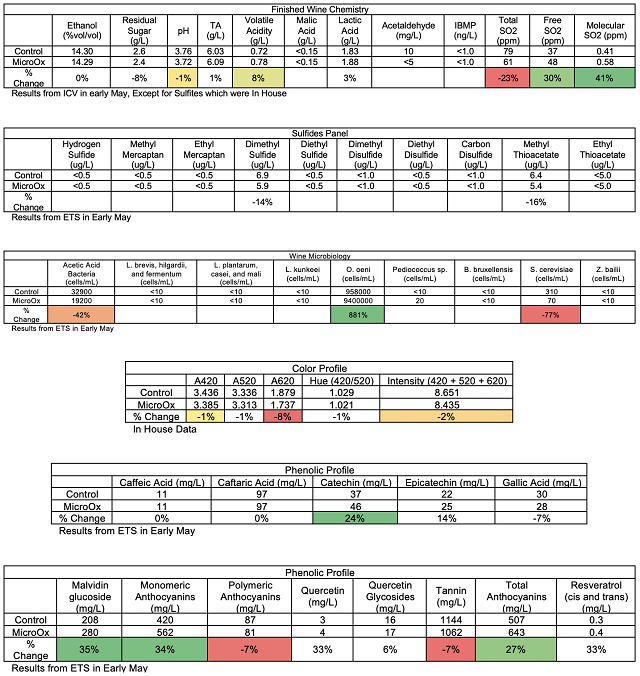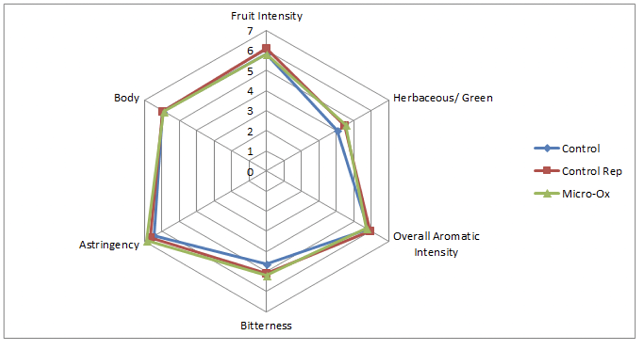The Impact of Micro-oxygenation in Tannat (2017)
Joy Ting
Michael Shaps Wineworks
Summary
This study examines the impact of micro-oxygenation in aging Tannat wine. Tannat wine was split into two identical tanks. The treatment tank was micro-oxygenated with a dosing stone through a Stavin Ox Box. Due to the small volume of wine, continuous micro-oxygenation was not possible, and instead a discontinuous regimen was put in place with a target oxygen rate of 5 mL O2/L wine/month. This was achieved by dosing the wine with 0.61mL O2/minute for approximately 10 hours every 3-5 days. Treatment was halted when malolactic conversion began. Chemistry results were not too different, except for sulfur dioxide binding (where more sulfur dioxide was binding in the control). Sulfides were not very different, and differences in Oenococcus are likely not due to the treatment. Color was not very different. The micro-ox wine had higher levels of anthocyanins, but slightly lower polymeric pigment and tannin. For the triangle test, of 27 people who answered, 5 people chose the correct wine (19%), suggesting that these wines were not significantly different. In fact, this suggests that judges consistently and significantly did not choose the correct wine and were biased to the replicates (p<0.05). In general, of people who answered correctly, 3 preferred the micro-ox wine, and 2 preferred the control wine. For the descriptive analysis, there were no strong trends for the descriptors used in this study. There may have been a slight tendency for the micro-ox wine to have higher Astringency, but this was very weak. These kinds of studies should be repeated in the future, over multiple varieties, utilizing both continuous and discontinuous micro-oxygenation schemes. Furthermore, more intensive micro-oxygenation regimens should be performed in future studies.
Introduction
Just after completion of red wine fermentation, limited oxygen exposure may have beneficial impacts on red wine phenolic attributes, such as by enhancing color stability, softening tannin, and providing body (Zoecklein 2001a). Aeration can also help if done during alcoholic fermentation (macro-oxygenation), it can help reduce reductive aromas (although sometimes it may not effectively combat reduction), and integrate overall aromatic quality of the wine (Zoecklein 2000). Aeration both during and after fermentation can promote the formation of polymeric pigment, stabilizing color. Aeration is more beneficial at this point due to the higher levels of phenolic compounds in the wine and the greater protection of the wine at this stage due to negative oxidation reactions. Oxidation reactions are promoted in both rate and extent by higher pH, and the formation of acetaldehyde through oxygenation can promote tannin-anthocyanin bridging resulting in stable pigment. The presence of sulfur dioxide can result in acetaldehyde binding, which may inhibit the formation of these acetaldehyde-based polymeric pigments. Thus, it is often recommended that sulfur dioxide be kept low during the course of micro-oxygenation treatments (Zoecklein 2001a). Research by Patrick Sullivan has suggested that micro-oxygenated wines had greater perceptions of fruit intensity, plushness, and less vegetative aromas (Zoecklein 2001b). The purpose of the present study is to investigate the role of micro-oxygenation in helping to age Tannat wine.
Results and Discussion
Chemistry results were not too different, except for sulfur dioxide binding (where more sulfur dioxide was binding in the control). Sulfides were not very different, and differences in Oenococcus are likely not due to the treatment. Color was not very different. The micro-ox wine had higher levels of anthocyanins, but slightly lower polymeric pigment and tannin. For the triangle test, of 27 people who answered, 5 people chose the correct wine (19%), suggesting that these wines were not significantly different. In fact, this suggests that judges consistently and significantly did not choose the correct wine and were biased to the replicates (p<0.05). In general, of people who answered correctly, 3 preferred the micro-ox wine, and 2 preferred the control wine. For the descriptive analysis, there were no strong trends for the descriptors used in this study. There may have been a slight tendency for the micro-ox wine to have higher Astringency, but this was very weak. These kinds of studies should be repeated in the future, over multiple varieties, utilizing both continuous and discontinuous micro-oxygenation schemes. Furthermore, more intensive micro-oxygenation regimens should be performed in future studies.


Methods
Tannat grapes from the Honah Lee vineyard were crushed and destemmed into tank, inoculated with RBS133 yeast and allowed to undergo fermentation under standard conditions. Superfood and DAP were added as necessary. When fermentation was complete, wine was pressed off skins and seeds, and transported from the Wineworks satellite location to the Harris Creek Location. Wine was allowed to settle after transport, then racked into two 1200 L tanks, splitting the lot into control and treatment. NTU was measured at 46 and DO was measured for the control tank at 0.47 and 0.32 for the treatment tank. An NTU less than 200 was desired to prevent aerative spoilage organisms and particulate binding sites for oxygen. Glycol was set to 55 degrees on each tank and temperature was tested prior to each oxygen dose. Lead lines from the Stavin Ox Box were threaded into the treatment tank so that dosing stones were suspended 1 inch from the bottom of the tank (to avoid lees). Lines remained in place for the duration of the experiment to avoid oxygen addition from disturbing the surface.
Due to the small volumes of each tank (1125 L), continuous dosing was not possible from the Ox Box. Instead, a discontinuous rate was set targeting 5 mL/L/month, at a dose rate of 0.61 mL/min for 10 hours every 3-5 days. Temperature was checked prior to each oxygen dose. Dissolved oxygen was checked before and after each dose. Throughout the experiment, both lots were tested weekly for sensory attributes (specifically tannin structure, offensive odors, and oxidation), sulfur dioxide levels (which should be very low), and VA. Malic acid was checked once per week. Treatment was halted when malolactic fermentation began in one tank. The other tank was then inoculated for malolactic fermentation. After malolactic fermentation was complete, sulfur dioxide was added and wine was racked to barrel for aging.
These wines were tasted on May 30. For the triangle test, descriptive analysis, and preference analysis, anybody who did not answer the form were removed from consideration for both triangle, degree of difference, and preference. Additionally, anybody who answered the triangle test incorrectly were removed from consideration for degree of difference and preference. Additionally, any data points for preference which did not make sense (such as a person ranking a wine and its replicate at most and least preferred, when they correctly guessed the odd wine) were removed.
In order to balance the data set to perform statistical analysis for descriptive analysis, any judge who had not fully completed the descriptive analysis ratings were removed. In order to then make the number of judges between groups equivalent, one judge from group 1 was transferred to group 3, and another judge from groups 1 and 2 were eliminated. This resulted in a final data set of 3 groups, each with 6 judges (considered as replications within groups, and groups were considered as assessors). Data was analyzed using Panel Check V1.4.2. Because this is not a truly statistical set-up, any results which are found to be statistically significant (p<0.05) will be denoted as a “strong trend” or a “strong tendency,” as opposed to general trends or tendencies. The statistical significance here will ignore any other significant effects or interactions which may confound the results (such as a statistically significant interaction of Judge x Wine confounding a significant result from Wine alone). The descriptors used in this study were Fruit Intensity, Herbaceous/Green, Overall Aromatic Intensity, Bitterness, Astringency, and Body.
References
Zoecklein, B. 2000. Vintner’s corner: Microoxygenation. Vol 15, No. 2. http://www.apps.fst.vt.edu/extension/enology/VC/MARAPR00.html. Accessed 5/31/2018.
Zoecklein, B. 2001a. Enology Notes #33: Controlled aeration of red wines. http://www.apps.fst.vt.edu/extension/enology/EN/33.html. Accessed 5/31/2018.
Zoecklein, B. 2001b. Vintner’s corner: Microoxygenation research. Vol 16, No. 6. http://www.apps.fst.vt.edu/extension/enology/VC/Nov-Dec01.html#Micro. Accessed 5/31/2018.
